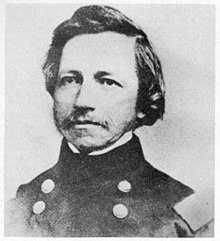Amiel Weeks Whipple
Amiel Weeks Whipple | |
|---|---|
 Amiel Weeks Whipple | |
| Born | October 15, 1818 Greenwich, Massachusetts |
| Died | May 7, 1863 (aged 44) Washington, D.C. |
| Place of burial | Proprietors' Cemetery, Portsmouth, New Hampshire |
| Allegiance | United States of America Union |
| Service | United States Army Union Army |
| Years of service | 1841–1863 |
| Rank | |
| Battles / wars | American Civil War |
Lt. Amiel Weeks Whipple (October 15, 1818 – May 7, 1863)[1] was an American military engineer and surveyor. He served as a brigadier general in the American Civil War, where he was mortally wounded at the Battle of Chancellorsville. He was the topographical engineer/surveyor in charge of the 1853-1854 Pacific Railroad Survey from Arkansas to Los Angeles in 1853 and 1854, for a potential transcontinental railroad route.[2]
His name is memorialized on 2 forts — Fort Whipple, the Arizona Territory's first capital, and Fort Whipple,[3] Arlington County, Virginia, now Fort Myer.[4] — and around northern Arizona: Whipple Street, Whipple Stage, Whipple Mountains, Whipple Mountains Wilderness. Numerous plants taxa were named in his honor, including the genus Whipplea and species Hesperoyucca whipplei.
Biography
Whipple was born to David and Abigail Brown Pepper Whipple in Greenwich, Massachusetts. He attended Amherst College and West Point, graduating in the Class of 1841. His early career including surveying the Patapsco River, sounding and mapping the approaches to New Orleans, surveying Portsmouth Harbor, and, as a lieutenant, helping to determine portions of the United States' borders with Canada and Mexico.
In 1853 he led explorations for the first transcontinental railroad route to the Pacific Ocean, near the 35th parallel. From 1855 to 1857, Whipple published Explorations and Surveys for a Railroad Route from the Mississippi River to the Pacific Ocean.[5] Among other things, the book contains the formal botanical description of the cactus species Opuntia davisii, and others of which Whipple is a binomial author, known as an "in" author.[6]
Whipple converted to Catholicism in Detroit circa 1857, when commanding the lighthouse districts from Lake Superior to the Saint Lawrence River.
During the Civil War, Whipple first served under General Irvin McDowell, then became chief topographical engineer under General George B. McClellan in the Army of the Potomac. His maps were used on many Virginia battlefields. In 1862, as brigadier general of volunteers, he led the defense of Washington, D.C., on its Virginia side. After great gallantry at Fredericksburg, where he led third division III Corps, Whipple was severely wounded by a sharpshooter at Chancellorsville, and received the last rites on the battlefield. Taken to Washington he was breveted brigadier-general on May 4, major general of volunteers on May 6, and major-general by brevet on May 7, only a few hours before his death in Washington. He was buried in the Proprietors' Cemetery, Portsmouth, New Hampshire.
One of the Defenses of Washington[7] was named in his honor — Fort Whipple [8] which was later renamed Fort Myer [9] since there was already a Fort Whipple in Arizona.
See also
References
![]() This article incorporates text from a publication now in the public domain: Herbermann, Charles, ed. (1913). "Whipple, Amiel Weeks". Catholic Encyclopedia. New York: Robert Appleton Company. pp. 608–609.
This article incorporates text from a publication now in the public domain: Herbermann, Charles, ed. (1913). "Whipple, Amiel Weeks". Catholic Encyclopedia. New York: Robert Appleton Company. pp. 608–609.
- ^ Whipple, Blaine (2007). 15 Generations of Whipples: Descendants of Matthew Whipple of Ipswich, Massachusetts. Baltimore, Maryland: Gateway Press, Inc. pp. G631–G639. ISBN 978-0-9801022-4-6.
{{cite book}}: Cite has empty unknown parameter:|coauthors=(help) - ^ Sherburne, John Pitts and Mary McDougall Gordon. Through Indian Country to California: John P. Sherburne's Diary of the Whipple Expedition, 1853-1854 (1988 ed.). Stanford University Press. p. 285.
- ^ http://www.historic-fortmyer.com/2011/03/20/fort-whipple-virginia/
- ^ [1]
- ^ Description of the Cactaceae "Explorations and Surveys for a Railroad Route from the Mississippi River to the Pacific Ocean". IPNI. pp. [27]–58. Retrieved 22 March 2013.
- ^ Cactaceae Opuntia davisii Engelm. & J.M.Bigelow in Whipple. It is a taxonomic synonym of the accepted name Cylindropuntia davisii (Engelm. & J.M.Bigelow) F.M.Knuth "Plant Name Details for Opuntia davisii". IPNI. Retrieved 22 March 2013.
- ^ http://www.historic-fortmyer.com/2012/02/15/defenses-of-washington/
- ^ http://www.historic-fortmyer.com/2011/03/20/fort-whipple-virginia/
- ^ http://www.historic-fortmyer.com/
- ^ International Plant Names Index. Whipple.
